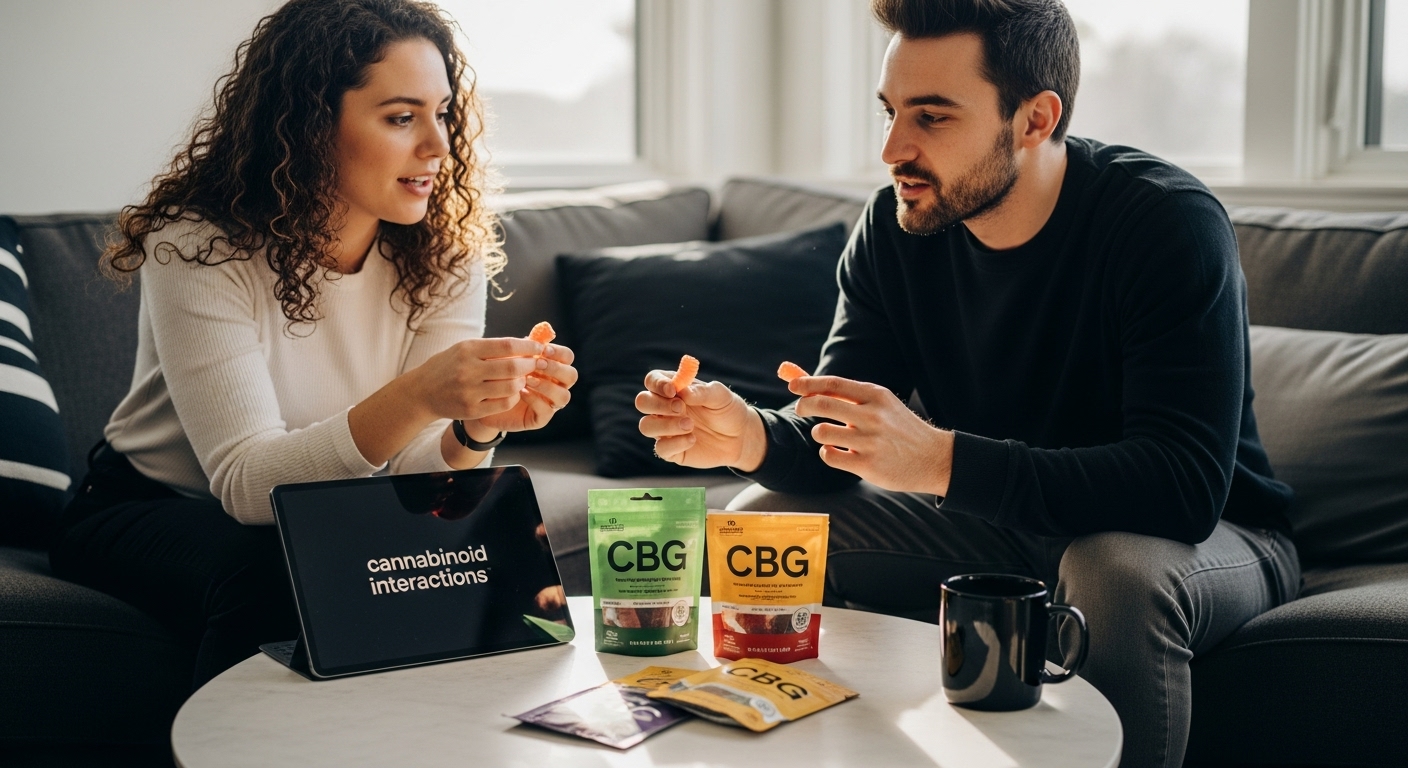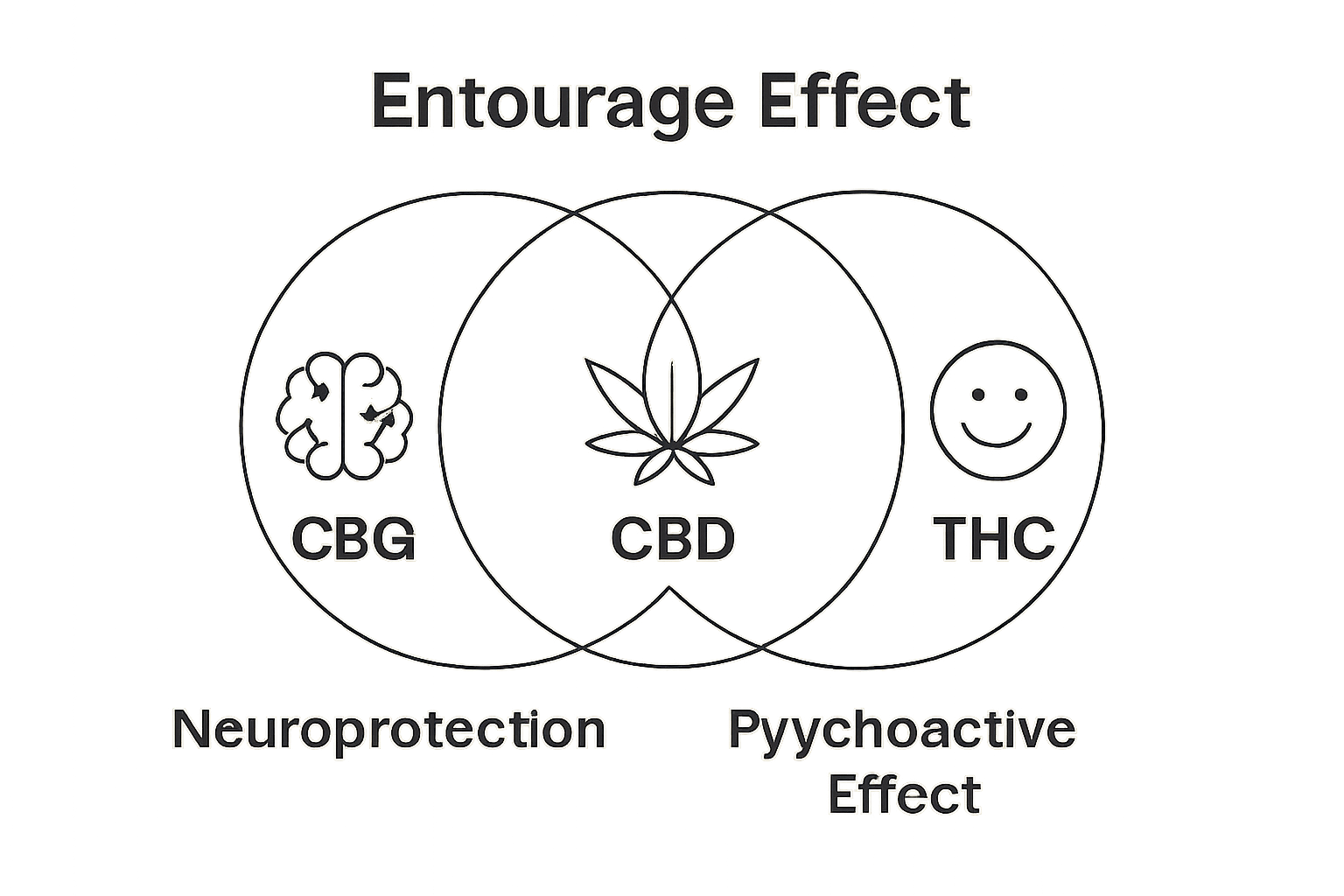Blog
Understanding the Role of CBG in Edibles
Cannabigerol or CBG is making waves among cannabis researchers for a reason. While CBD and THC usually get the spotlight, it turns out CBG is the “mother” compound—the source from which other cannabinoids form. Most people assume new cannabinoids are just more of the same, but CBG is breaking that mold. Its non-psychoactive nature and unique therapeutic effects have scientists rethinking what cannabis can really offer.
Table of Contents
- What Is CBG And Its Unique Properties?
- The Importance Of CBG In Cannabis Edibles
- How CBG Interacts With Other Cannabinoids
- Health Benefits Of CBG In Edible Products
- Future Trends: CBG’s Role In The Edibles Market
Quick Summary
| Takeaway | Explanation |
|---|---|
| CBG is a foundational cannabinoid | CBG is known as the “mother of all cannabinoids” because it serves as a precursor to other cannabinoids like THC and CBD. |
| CBG does not produce psychoactive effects | Unlike THC, CBG is non-psychoactive, making it a safer option for therapeutic use without the high. |
| CBG may enhance edible therapeutic effects | It contributes to the entourage effect, potentially amplifying the health benefits of other cannabinoids in edibles. |
| CBG shows promise in various health areas | Studies suggest CBG may help with neuroprotection, inflammation, and appetite regulation, highlighting its therapeutic potential. |
| The CBG market is expanding rapidly | As consumer interest grows, innovations in CBG extraction and formulations are likely to drive the development of new wellness products. |
What is CBG and Its Unique Properties?
Cannabinoids continue to fascinate researchers and wellness enthusiasts, and cannabigerol (CBG) stands out as an intriguing compound with remarkable potential. Often called the “mother of all cannabinoids,” CBG serves as a foundational molecule from which other cannabinoids are synthesized, making it a critical component in understanding cannabis biochemistry. Research from the National Institutes of Health highlights its unique molecular structure and emerging therapeutic possibilities.
The Origin and Molecular Composition of CBG
CBG begins its journey as cannabigerolic acid (CBGA), the precursor molecule in cannabis plants. During plant growth and under specific environmental conditions, CBGA transforms into various other cannabinoids through enzymatic processes. This transformative characteristic makes CBG distinctly different from more well-known cannabinoids like CBD and THC. Unlike THC, CBG does not produce psychoactive effects, which makes it particularly interesting for medical and wellness applications. Read more about CBG in our comprehensive guide.
Potential Therapeutic Benefits
Preliminary scientific investigations suggest CBG possesses several promising properties that set it apart from other cannabinoids. Its potential benefits include:
- Neuroprotective Effects: Early studies indicate CBG might support brain health
- Anti-Inflammatory Properties: Research suggests potential reduction in inflammatory responses
- Antibacterial Capabilities: Initial research points to possible antimicrobial characteristics
While more comprehensive human studies are needed, these initial findings position CBG as a fascinating compound with significant potential in wellness and medical research.
Here is a summary table outlining the potential therapeutic benefits of CBG specifically highlighted in the article:
| Benefit Area | Description of CBG Potential Impact |
|---|---|
| Neuroprotective Effects | May support brain health and neural function |
| Anti-Inflammatory | Potential reduction in systemic and localized inflammation |
| Antibacterial | Initial research points to possible antimicrobial characteristics |
| Mood Regulation | Possible support for emotional balance and stress management |
| Digestive Support | Preliminary indications of positive gastrointestinal system interactions |
| Appetite Regulation | Early research suggests influence on metabolism and appetite |
| The complexity of its interactions with the human endocannabinoid system continues to intrigue scientists and health professionals alike. |
To clarify the differences between major cannabinoids mentioned in the article, here is a comparison of CBG, CBD, and THC based on their properties and effects:
| Cannabinoid | Psychoactive? | Role in Plant | Key Therapeutic Effects | Interest in Edibles |
|---|---|---|---|---|
| CBG | No | Precursor (“Mother” of cannabinoids) | Neuroprotective, anti-inflammatory, antibacterial, mood and appetite regulation | Growing for non-psychoactive therapeutic benefits |
| CBD | No | Derived from CBGA via CBG | Anti-inflammatory, anxiolytic, neuroprotective | Widely used for wellness, non-intoxicating |
| THC | Yes | Derived from CBGA via CBG | Psychoactive, pain relief, appetite stimulation | Traditional focus, but limits some users due to psychoactivity |
The Importance of CBG in Cannabis Edibles
As the cannabis industry continues evolving, cannabigerol (CBG) emerges as a significant player in edible formulations, offering unique characteristics that distinguish it from other cannabinoids. Research from scientific journals indicates CBG contributes substantially to the overall therapeutic and sensory experience of cannabis edibles.
Enhanced Cannabinoid Interactions
CBG plays a crucial role in what researchers call the “entourage effect,” where multiple cannabinoids work synergistically to produce more comprehensive wellness benefits. Unlike isolated cannabinoids, CBG interacts with the body’s endocannabinoid system in nuanced ways, potentially amplifying the overall impact of edible products. Learn more about cannabis edible terminology to understand these complex interactions.
Potential Health and Wellness Benefits
In cannabis edibles, CBG demonstrates promising characteristics that make it valuable for consumers seeking specific wellness outcomes. Its potential benefits include:
- Mood Regulation: Potential support for emotional balance and stress management
- Digestive Support: Preliminary indications of gastrointestinal system interactions
- Appetite Stimulation: Early research suggests potential metabolic influences
By incorporating CBG into edibles, manufacturers can create more comprehensive and targeted products that address diverse consumer needs. The compound’s non-psychoactive nature makes it particularly appealing for individuals seeking therapeutic benefits without experiencing intoxication.
How CBG Interacts with Other Cannabinoids
Cannabinoids do not exist in isolation but rather function within a complex molecular ecosystem where interactions and synergies play a critical role. Research published in neurological journals reveals CBG’s unique capacity to modulate and enhance interactions between different cannabinoid compounds, creating a sophisticated biochemical dialogue within the human body.
The Entourage Effect Mechanism
The “entourage effect” represents a fundamental principle in cannabinoid science where different compounds work collaboratively to produce more comprehensive therapeutic outcomes. CBG acts as a molecular conductor, subtly influencing how other cannabinoids like THC and CBD interact with the body’s endocannabinoid receptors. Explore our comprehensive guide on cannabis edible terminology to understand these intricate interactions more deeply.
Receptor Interaction Dynamics
CBG demonstrates remarkable versatility in its interactions with cannabinoid receptors. Its potential impacts include:
- CB1 Receptor Modulation: Potentially reducing psychoactive effects of THC
- CB2 Receptor Engagement: Supporting immune system and inflammation responses
- Receptor Site Competition: Influencing how other cannabinoids bind and function
By acting as a mild antagonist and regulator, CBG can potentially mitigate some of the less desirable effects associated with other cannabinoids while enhancing their overall therapeutic potential.
 This nuanced interaction underscores CBG’s importance in creating balanced and effective cannabinoid formulations.
This nuanced interaction underscores CBG’s importance in creating balanced and effective cannabinoid formulations.

Health Benefits of CBG in Edible Products
Cannabinoid research continues to uncover remarkable therapeutic potential, with CBG emerging as a particularly promising compound for wellness applications. Preclinical studies reveal intriguing possibilities for CBG’s impact on human health through edible consumption, offering a nuanced approach to wellness that extends beyond traditional cannabinoid applications.
Neurological and Mental Wellness
CBG demonstrates significant potential in supporting neurological function and mental wellness. Unlike THC, CBG does not produce psychoactive effects, making it an attractive option for individuals seeking therapeutic benefits without cognitive impairment. Check our comprehensive guide on cannabis edible labeling to understand product specifics and potential benefits.
Targeted Health Support
Researchers have identified several promising areas where CBG in edible products might offer substantial health benefits:
- Inflammatory Response Management: Potential reduction in systemic inflammation
- Neuroprotective Properties: Support for brain cell health and neural function
- Appetite and Metabolic Regulation: Potential influence on digestive processes and metabolic balance
These potential benefits highlight CBG’s complexity as a therapeutic compound. While more comprehensive human studies are needed, early research suggests CBG could play a significant role in holistic wellness strategies, offering consumers a nuanced approach to supporting their overall health through carefully formulated edible products.
Future Trends: CBG’s Role in the Edibles Market
The cannabis industry is experiencing a transformative period, with cannabigerol (CBG) emerging as a significant catalyst for innovation in edible product development. Market research indicates growing consumer interest in novel cannabinoid formulations that offer targeted wellness experiences beyond traditional THC and CBD offerings.
Market Evolution and Consumer Preferences
Consumers are increasingly seeking personalized, nuanced cannabinoid experiences that address specific wellness needs. CBG represents a promising frontier in this evolving landscape, offering potential benefits without psychoactive effects. Explore our guide on popular cannabis edible examples to understand the diverse potential of cannabinoid-based products.
Technological and Research Advancements
The future of CBG in edibles is being shaped by several key developments:
- Extraction Technologies: Improved methods for isolating and concentrating CBG
- Formulation Innovations: Creating more targeted and effective edible products
- Research Investment: Increasing scientific understanding of CBG’s potential
As research continues to unveil CBG’s complex interactions and potential benefits, manufacturers and researchers are positioning this cannabinoid as a critical component in next-generation wellness products. The market is poised for significant growth, with CBG potentially revolutionizing how consumers approach holistic health and well-being through innovative edible formulations.
Experience the Full Potential of CBG in Every Gummy
Are you searching for edibles that deliver more than just relaxation? The article “Understanding the Role of CBG in Edibles” highlights how CBG stands out in cannabinoid science by offering unique benefits like mood regulation, inflammation support, and advanced synergy with other cannabinoids. Many gummies on the market lack true full-spectrum benefits or trustworthy lab transparency, leaving wellness-focused individuals with limited choices. At Good Tide CBD Gummies, we solve this problem by crafting gummies with solventless hash rosin, capturing the full essence of CBG and its entourage effect for a naturally potent experience.

Ready to discover how quality extraction and authentic flavors can transform your edible journey? Explore our premium range on the Good Tide CBD Gummies shop and see how our third-party lab tested products stand apart. With detailed product information, genuine customer reviews, and exclusive community offers, now is the time to make the most of CBG’s potential. Start experiencing transparent, full-spectrum relief at https://goodtidecbdgummies.com today.
Frequently Asked Questions
What is CBG and how does it differ from other cannabinoids?
CBG, or cannabigerol, is known as the “mother of all cannabinoids” and serves as a precursor to other cannabinoids like THC and CBD. Unlike THC, CBG is non-psychoactive, making it appealing for various wellness applications without causing intoxication.
What are the potential health benefits of CBG in edible products?
CBG may offer several health benefits, including neuroprotective effects, anti-inflammatory properties, and appetite stimulation. Research suggests it can support brain health, reduce inflammation, and possibly assist with digestive processes.
How does CBG contribute to the entourage effect in cannabis edibles?
CBG enhances the entourage effect, where multiple cannabinoids work synergistically to improve their therapeutic benefits. By interacting with the body’s endocannabinoid system, CBG can amplify the overall effectiveness of other cannabinoids in edible products.
Why are consumers interested in CBG-infused edibles?
Consumers are increasingly drawn to CBG-infused edibles for their unique potential to support wellness without the psychoactive effects of THC. This interest reflects a growing demand for personalized and nuanced cannabinoid experiences that address specific health needs.
Recommended
- What is CBG in Gummies? Understanding the Benefits – GOOD TIDE CBD GUMMIES
- Understanding Cannabis Edible Labeling for Consumers – GOOD TIDE CBD GUMMIES
- Understanding Cannabis Edible Terminology Explained – GOOD TIDE CBD GUMMIES
- Understanding Cannabis Edibles Basics for Everyone – GOOD TIDE CBD GUMMIES

